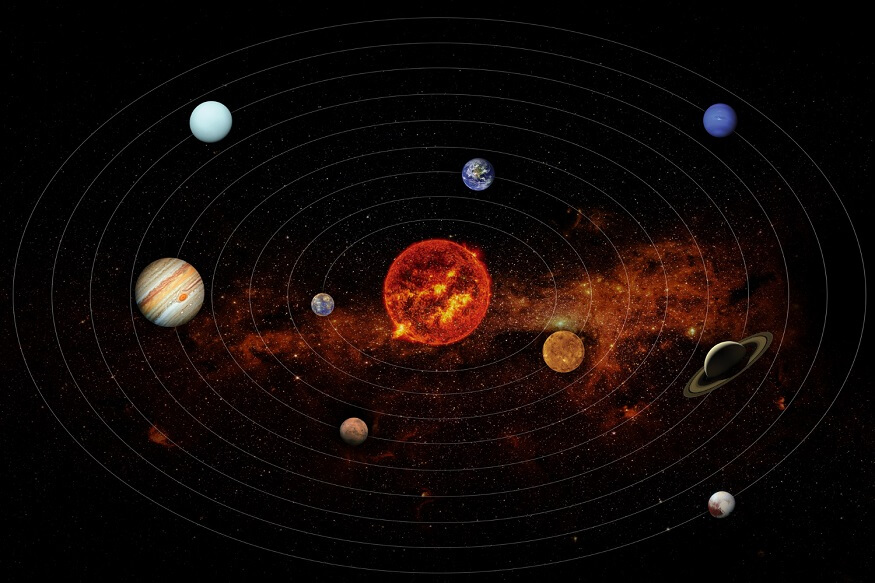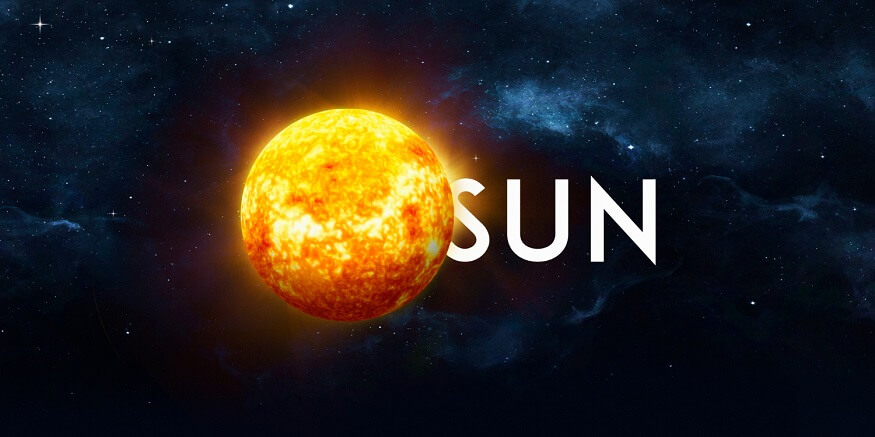The solar system is a fascinating place to study. Scientists have researched and are still researching new and upcoming objects day and night to discover celestial objects. There are studies specifically dedicated to space and the solar system. This study is called Astronomy. Imagine leaving the Earth behind and exploring the solar system facts. It is called the solar system because everything in it is centred around the Sun, and the word ‘solar’ means something to do with the Sun.
Also Read: Tips To Get Children Interested In Space Science
Information on planets & the Sun in the solar system
Some of the solar system facts and information on planets in the solar system are below:
The Sun
The closest star known to humans until today is the Sun. It is at a great distance from our planet standing at approximately 93 million miles, which is why it looks that small from the earth, even though it is the largest celestial in the Solar system. if Sun were a giant box, it could have easily fit a million earths into the box. Sun has an enormously powerful gravitational force that keeps all the planets in place.
The Mercury
The first planet that will be met is Mercury. It is the smallest planet, much smaller than the Earth in the solar system. it is visible from Earth with only our eyes. It is small and has a rocky outer surface texture with craters on it. It has no moon of its own and no air to breathe. The temperature of mercury is boiling hot in the Sun and freezing cold in the shade. One of the Interesting facts about the solar system on Mercury is that it is the fastest planet to go around the Sun, it only takes 88 days for this planet to circle around the Sun just like how Earth takes 365 days to go around.
The Venus
Some people call Venus Earth’s sister because the two planets are remarkably close in size and gravity, but they are vastly different on the surface. The temperature of Venus is off the charts making it the hottest planet in the entire lot. It’s not as close to the Sun as Mercury, but its thick atmosphere of carbon dioxide helps it to trap the heat and stay warmer than its neighbour.
The Earth
After Venus comes the Earth, the third planet from the Sun and the fifth biggest planet in the solar system. Earth is what is called the ‘Goldilocks planet’ because it is not too hot and not too cold, it has just the right temperature. Earth is the only planet adaptable to life, holding living organisms.
The Mars
Mars is the Fourth planet from the Sun. Mars is known as the red planet, because of iron oxide in the soil, it is material like rust which makes it appear reddish in colour. This reddish colour is due to carbon dioxide and oxygen in the atmosphere. It has a really low temperature. There is water and ice on Mars. Scientists are extremely interested in Mars because there is a slight possibility according to research that humans can sustain life on Mars with some kind of special device or equipment. Mars’s moons are small and irregular in shape. Scientists think that they might be captured by asteroids.
Also Read: Interesting Facts about Space for Kids
The Jupiter
Jupiter is the biggest planet in the solar system and is called a ‘gas giant’. It is really big and made mostly of gases. Jupiter is so big that 11 Earths could be placed end-to-end just to stretch across its middle. When looking at the night sky during sunset, Jupiter can be seen with the naked eye. It has a total of 67 moons. People cannot land on Jupiter because it is made of gas, there is no ground to land on.
The Saturn
After Jupiter comes Saturn, another gas giant, and the second-biggest planet in the solar system. Saturn is famous for its beautiful rings. Although they look solid from a distance, the rings are actually made from many small ice particles, rocks, and dust. Saturn has 60 moons orbiting around it. An interesting fact about the solar system based on Saturn is that even though it is exceptionally large, it is not dense. That means that if there is a bathtub large enough to put Saturn in, it would float.
The Uranus
This planet is famously known for its beautiful array of colours. It is blue in colour and looks astonishing. Uranus is a planet that is the seventh planet from the sun and is another gas giant. It is much smaller than Saturn and Jupiter but is the third biggest planet in the solar system. Unlike any other planet in the solar system, it is tilted so much that it spins sideways. Uranus is covered in blue clouds made of methane, which gives it its lovely colour.
The Neptune
Like Uranus is Neptune, the eighth planet from the sun and the fourth biggest planet in the solar system. Neptune is another gas giant and like Uranus has methane in its atmosphere which makes it blue. Neptune is a darker blue than Uranus and scientists are not sure why. Neptune has a few thin rings and 14 moons. Because Neptune is so far out in space, it takes an exceedingly long time to go around the Sun. Poor Neptune takes over 164 years to finish an orbit around the Sun.
Pluto
Pluto was discovered in 1930 and was listed as the ninth planet in the solar system. As it was studied longer, scientists realised how small it is. It is much smaller than any other planet in the solar system, and even smaller than many other moons, some were even bigger than Pluto. In 2006, after 76 years of being listed as a planet Pluto was declared a ‘dwarf planet’.
Also Read: Science Stream Career Options after 10th & List of Courses after 12th
Conclusion
That sums up all the 8 planets in our solar system. These are some of the solar system facts and information on planets in the solar system. In EuroSchool, within the science subject curriculum, we have included the study of the solar system and various interesting facts about the solar system and information on planets in the solar system.










